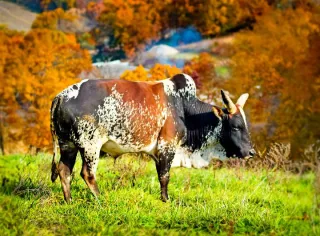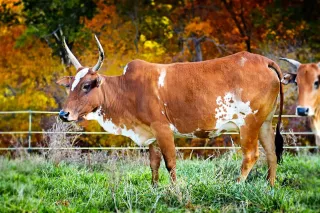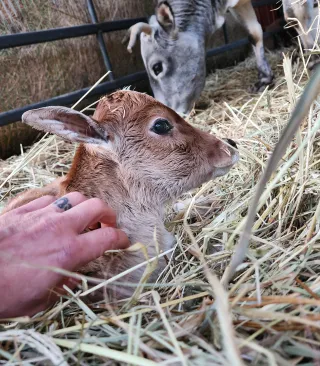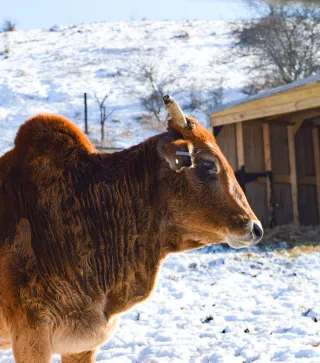Welcome to
The Mini Moos of Circle K
Kaufman Ventures LLC
Miniature Zebu FAQs
What is a Miniature Zebu?
Miniature Zebu Cattle originally from the jungles of South Asia. They are thought to be one of the oldest breeds of cattle, possibly dating back as far as 6000 B.C. Miniature Zebu are one of the smallest breed of cattle in the world. They are "known" for their characteristic of its hump on the upper back located right behind the head and neck.

How long do Miniature Zebu Live?
Miniature Zebu have a long lifespan, living 20 plus years with good care.
Pictured here is one of our oldest cows 758 Pullao. She was born in 2003.

What height are Miniature Zebu?
There is no minimal height for Miniature Zebu but an adult Zebu should not exceed 42" when measured right behind the hump.
The average height is between 34 and 38 inches tall when measured behind the hump.
What is the average weight of a Miniature Zebu?
Mature cows average a weight of 300-500lbs with bulls averaging 400-600lbs. Newborn Zebu Calves are extremely petite, almost fawn like. Newborn calves average 13-18 inches tall and weigh 15-22lbs.

What uses do Miniature Zebu have?
Miniature Zebu are a versatile breed with varying uses and styles depending on pedigree, conformation and training. They can be used for Draft Animals, Show Stock (FFA-4H), Breeding, Meat and Milk, Petting Zoos, Junior Rodeo Bucking Stock, Pets and more!
How do Miniature Zebu handle the summer heat and cold winter weather?
Miniature Zebu are a tropical breed and handle the heat very well. As far as the cold weather, as long as you furnish them with proper shelter in the winter months out of the wind and rain/snow they will be fine. Good bedding is essential as well to keep them off the cold floor when they are in their shelter. Care should be taken to prevent hypothermia when calves are expected in the winter months.

What age do Miniature Zebu start to breed?
Bulls can start breeding as young as 1 year of age. Heifers normally do not sexually mature as fast as bulls. Most can be bred at 2 to 2.5 years of age. Some have been known to breed much sooner or to take as long as 3 to 4 years of age to be bred.
How many acers do I need to keep Miniature Zebu and how much do they eat?
If you expect to not supplement with hay during grazing months you will need 1 acre per 3 Miniature Zebu with good established grass for grazing. Depending on your area you may need more or less acreage per head. Their small size is easier on the land and fencing. They are much less destructive to pastures, feed and hay cost are lower then normal size cattle. They eat about 1/3 to 1/4 the amount of standard size cattle.
How trainable are Miniature Zebu?
Miniature Zebu calves are very intelligent and highly trainable if handled properly. We use a lot of equine training techniques and methods with our Miniature Zebu calves.
What is the BDZ and BD1 genetic defect in miniature cattle?
BDZ- Bulldog Dwarfism (Chondrodysplasia) in Miniature Zebus
Quick Summary
Bulldog dwarfism is a lethal genetic defect of Miniature Zebu cattle. Affected fetuses have disproportionate dwarfism, a short and compressed vertebral column, a large head, short, stocky limbs, and are naturally aborted around seven months of gestation. The mutation that causes this defect is specific to Zebu cattle and is different from the Dexter mutations.
Alleles: N = Normal/Unaffected, BDz = Bulldog dwarfism
Explanation of Results: Cattle with N/N genotype will not have bulldog dwarfism and cannot transmit this bulldog dwarfism variant to their offspring. Cattle with N/BDz genotype will not be affected by bulldog dwarfism, but are carriers. They will transmit this bulldog dwarfism variant to 50% of their offspring. Matings between two carriers result in a 25% chance of producing a calf with bulldog dwarfism. Cattle with BDz/BDz genotype will have bulldog dwarfism. Fetuses with this genotype are expected to naturally abort.
BD1-Bulldog Dwarfism (Chondrodysplasia) in Dexters
Bulldog dwarfism is a lethal genetic defect of Dexter cattle. Affected fetuses have severe disproportionate dwarfism, a short vertebral column, a large head, and are naturally aborted around seven months of gestation. The two known mutations are specific to Dexter cattle and may be present in Dexter crossbreds
Alleles: N = Normal/Unaffected, BD1 = Bulldog Dwarfism BD1 mutation, BD2 = Bulldog Dwarfism BD2 mutationBreeds appropriate for testing: Dexter, Dexter crosses, Miniature Jersey, Miniature Zebu, Miniature Scottish HighlandExplanation of Results:Cattle with N/N genotype will not have these types of bulldog dwarfism and cannot transmit either of these bulldog dwarfism variants to their offspring.Cattle with N/BD1 or N/BD2 genotype will not be affected by these types of bulldog dwarfism, but are carriers. They will transmit the bulldog dwarfism variant they carry to 50% of their offspring. Matings between two carriers result in a 25% chance of producing a calf with bulldog dwarfism.Cattle with BD1/BD1, BD2/BD2, or BD1/BD2 genotype will have bulldog dwarfism. Fetuses with any of these genotypes are expected to be naturally aborted around the seventh month of gestation.
Both test are done using hair samples and can be purchased on the UC Davis website Here